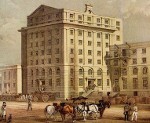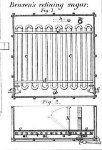

| Chancery Appeal Cases - No 110.—Tower Division Middlesex At a meeting of the commissioners of Assessed Taxes acting for the Tower Division, Middlesex, held at the Court House in Osbom-street Whitechapel, on the 6th day of July 1825; Mr Henry Nibbs Brown, of Betts-street, Ratcliff-highway, sugar refiner, appealed against a charge made upon him by Mr. Henry Feme, surveyor of taxes, for a clerk, warehouseman, or porter, employed by him between the 5th day of April 1823, and the 5th day of April 1824. From the evidence of the appellant it appears that he employed no male person whatever to write in any books in his counting house or warehouse, or keep any accounts in writing for him, except that the man called the boiler, who superintends the process of the manufacture of sugar, enters in a book an account of the quantities of raw material used, and the produce in marketable commodity, and that all books of account in the appellant's counting house are kept by himself only. The mode of carrying on the appellant's trade as far as regards the sale of sugar manufactured, is by sugar-brokers calling at the appellant's counting house, where the samples of sugar ready for sale are set out on a board, and carried by them to show their principals. The appellant attends the sugar market during the usual hours, for the purpose of completing the sale of sugar contracted for by the brokers; and if any person calls at the counting house of the appellant in his absence, relative to any purchases, he is referred to the appellant himself, there being no person in his absence authorized to transact any business. It is not the custom of the appellant to exhibit sugar in bulk, either to brokers or principals before sale; but after the sale, upon application from the buyer, it is shown to him by tbe boiler to ascertain whether it agrees with the sample, but this is very seldom done. The sugars when manufactured into lumps or loaves, are put into papers and packed for delivery as soon as sold, and this is done by the boiler or some other of the men employed in the manufacture. The commissioners being of opinion tbe appellant was liable to be charged for a warehouseman, confirmed the assessment; but the appellant being dissatisfied with their decision, contending that the boiler cannot be considered us a warehouseman employed in a shop or warehouse, wherein goods are sold or exposed to sale, but is merely a labourer in a manufactory, demanded a case, which we have stated, and signed for the opinion of some or one of the honourable the judges of the courts of King's Bench or Common Pleas, or barons of the Exchequer. Joseph Merceron, J. Parsey, James Usher, James Green,T. Mears 6th December 1825.— We are of opinion, that the determination of the commissioners is Wrong. J.A. Park, J. Burrough, W. Garrow, S. Gaselee. |
Alderman P.M. Martineau JP, Eastern Post 7 September 1901
also printed in H.C. Dimsdale Sixty Years' History of an East End Parish (Henry Bailey 1901) A
close shave for St George-in-the-East
A
close shave for St George-in-the-East in 1854 [pictured right], for an improvement in refining,
or 'blowing up', sugar to produces syrups at lower temperatures by
using perforated pipes rather than free steam: a contemporary report
explained that the invention mainly consisted in
employing numerous streams of air, introduced below the sugar and water
when in a suitable open vessel or pan, and heated by pipes having steam
or not fluid within them. For this purpose it is preferred to employ a
series of perforated pipes near the bottom of the pan or vessel and
above them to have a series of heated pipes capable of being raised out
of the fluid.
in 1854 [pictured right], for an improvement in refining,
or 'blowing up', sugar to produces syrups at lower temperatures by
using perforated pipes rather than free steam: a contemporary report
explained that the invention mainly consisted in
employing numerous streams of air, introduced below the sugar and water
when in a suitable open vessel or pan, and heated by pipes having steam
or not fluid within them. For this purpose it is preferred to employ a
series of perforated pipes near the bottom of the pan or vessel and
above them to have a series of heated pipes capable of being raised out
of the fluid. Some
of the reasons for the decline of the trade in East London are set out
above by Martineau. The trade was changing, as refined rather than loaf
sugar came to dominate the market, and large refineries replaced
smaller units. In 1864 Gladstone altered the duties on sugar,
stimulating exports of foreign refined sugar to Hull and other ports.
Scotland became a rival. In the mid-1860s, local refiners brokers and
wholesalers had a particular grievance over what they perceived to be
inequitable tariffs on the carriage of sugar from London, compared with
the rest of the country, and addressed a Memorial on the subject to the
railway companies. The list of signatories makes interesting reading:
there are still German firms, but most of the traders have English
names. This memorial was considered by the Royal Commission on
Railways, and can be read here
together with associated correspondence. It forms one example of a
wider concern debated by the Commission, as railways - though in
competition with each other - were becoming powerful and developing
monopolies within the transport sector.
Some
of the reasons for the decline of the trade in East London are set out
above by Martineau. The trade was changing, as refined rather than loaf
sugar came to dominate the market, and large refineries replaced
smaller units. In 1864 Gladstone altered the duties on sugar,
stimulating exports of foreign refined sugar to Hull and other ports.
Scotland became a rival. In the mid-1860s, local refiners brokers and
wholesalers had a particular grievance over what they perceived to be
inequitable tariffs on the carriage of sugar from London, compared with
the rest of the country, and addressed a Memorial on the subject to the
railway companies. The list of signatories makes interesting reading:
there are still German firms, but most of the traders have English
names. This memorial was considered by the Royal Commission on
Railways, and can be read here
together with associated correspondence. It forms one example of a
wider concern debated by the Commission, as railways - though in
competition with each other - were becoming powerful and developing
monopolies within the transport sector.Back to History page